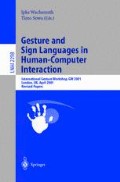Abstract
The SmartKom project is concerned with the development of an intelligent computer-user interface that allows almost natural communication and gesture input. For the training of the gesture analyzer, data is collected in so called Wizard-of-Oz experiments. Recordings of subjects are made and labeled off-line with respect to the gestures that were used. This article is concerned with the coding of these gestures. The presented concept is the first step in the development of a practical gesture coding system specifically designed for the description of communicative and non-communicative gestures that typically show up in human-machine dialogues. After a short overview over the development process and the special requirements for the project, the labels will be described in detail. We will conclude with a short outline of open points and differences to the well-known taxonomy for gestures of Ekman [1]. Keywords: Human-Machine interaction, annotation of corpora, multimodal dialogue systems, gesture coding system.
http://smartkom.dfki.de/index.html
Access this chapter
Tax calculation will be finalised at checkout
Purchases are for personal use only
Preview
Unable to display preview. Download preview PDF.
References
Ekman, P. (1999): Emotional and conversational nonverbal signals. In Messing, L. S., & Campbell, R. (Eds.), Gesture, speech and sign (p. 45–55). New York: Oxford University Press.
Faßnacht, G. (1979): Systematische Verhaltensbeobachtung. München: Reinhardt.
Beringer, N., Oppermann, D., & Burger, S. (2000): Transliteration spontan-sprachlicher Daten-Lexikon der Transliterationskonventionen. SmartKom Technisches Dokument Nr. 2.
Efron, D. (1941): Gesture and environment. Morningside Heights, NY: King’s Crown Press.
Bales, R. F. (1970):Personality and interpersonal behavior. New York: Holt.
McGrew, W. C. (1972):An ethological study of children’s behavior. New York: Academic Press.
Ekman, P., & Friesen, W. V. (1972): Hand movements. Journal of communication, 22, p.353–374.
Wallbott, H. G. (1982): Bewegungsstil und Bewegungsqualität. Weinheim, Basel: Beltz.
McNeill, D. (1992): Hand and Mind: What Gestures Reveal about Thought. Chicago: University of Chicago Press.
Laban, R. (1956): Principles of Dance and Movement Notation. London.
Jönsson, A., & Dahlbäck, N. (1988): Talking to a computer is not like talking to your best friend. Proc. of the First Scandinavian Conference on Artificial Intelligence, Tromso, Norway, p. 297–307.
Krout, M. H. (1935): Autistic gestures: An experimental study in symbolic movement. Psychological Monographs, 46, p.119–120.
Rosenfeld, H. M. (1966): Instrumental affiliative functions of facial and gestural expressions. Journal of Personality and Social Psychology, 4, p. 65–72.
Mahl, G. F. (1977): Body movement, ideation, and verbalization during psycho-analysis. In: N. Freedman & S. Grand (Eds.), Communicative structures and psychic structures. New York: Plenum Press, p. 291–310.
Freedman, N., Blass, T., Rifkin, A. & Quitkin, F. (1973): Body movement and the verbal encoding of aggressive affect. Journal of Personality and Social Psychology, p. 72–83.
Sainsbury, P., & Wood, E. (1977): Measuring gesture: Its cultural and clinical correlates. Psychological Medicine, 7, p. 63–72.
Kendon, A. (1980): Gesticulation and speech: two aspects of the process. In M. R. Key (ed.), The Relation Between Verbal and Nonverbal Communication. The Hague: Mouton.
Dahlbäck, N., Jönsson A., & Ahrenberg, L. (1993): Wizard of Oz Studies-Why and How. Knowledge-Based Systems, 6 (4), p. 258–266.
Friesen, W. V., Ekman, P., & Wallbott, H.G. (1979): Measuring hand movements. Journal of Nonverbal Behavior, 1, P. 97–112.
Author information
Authors and Affiliations
Editor information
Editors and Affiliations
Rights and permissions
Copyright information
© 2002 Springer-Verlag Berlin Heidelberg
About this paper
Cite this paper
Steininger, S., Lindemann, B., Paetzold, T. (2002). Labeling of Gestures in SmartKom - The Coding System. In: Wachsmuth, I., Sowa, T. (eds) Gesture and Sign Language in Human-Computer Interaction. GW 2001. Lecture Notes in Computer Science(), vol 2298. Springer, Berlin, Heidelberg. https://doi.org/10.1007/3-540-47873-6_24
Download citation
DOI: https://doi.org/10.1007/3-540-47873-6_24
Published:
Publisher Name: Springer, Berlin, Heidelberg
Print ISBN: 978-3-540-43678-2
Online ISBN: 978-3-540-47873-7
eBook Packages: Springer Book Archive

